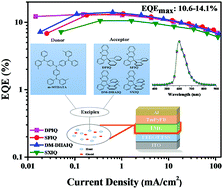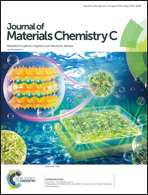Phenylquinoline fused cyclic derivatives as electron acceptors of exciplex forming hosts for solution-processable red phosphorescent OLEDs†
Abstract
Skeletons of phenylquinoline fused cyclic derivatives for electron accepting materials are synthesized and their thermal, electrochemical, photophysical and device optoelectronic properties are fully characterized. Density functional theory simulations coincide with the experimental results, which reveal the core role of the phenylquinolinyl moiety in both intra- and inter-molecular electronic transitions. Due to the high electron accepting capability of the quinolinyl moiety, blends of these compounds with the electron donor material 4,4′,4′′-tris(N-3-methylphenyl-N-phenylamino)triphenylamine form efficient exciplex hosts. Through the utilization of the exciplex hosts, simplified phosphorescent emitting devices with bis(2-phenylquinolinato)(2,4-pentanedionato)iridium [Ir(PQ)2acac] are constructed by the solution process. All of the devices exhibit a high performance ascribed to an efficient energy transfer and balanced charge carriers in the emission zone. External quantum efficiencies of the devices of up to a maximum of 14.1% are achieved and maintain a high level of 9.6–12.2% at 1000 cd m−2 and 6.5–8.2% at 10 000 cd m−2, respectively. The excellent performance of the device with the newly designed acceptor materials is in the top level of Ir(PQ)2acac based phosphorescent devices fabricated by the solution process.



 Please wait while we load your content...
Please wait while we load your content...